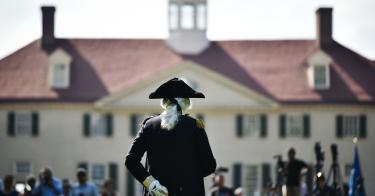America’s museums are at a crossroads. Will they be sites of civic education, centered on Americans’ shared history and principles? Or rallying points of advocacy, aiming to replace those principles with divisive identity politics?
Museums aren’t the only institutions facing such challenges. Our ultimate trajectory as a nation will be shaped by the outcomes of a multitude of disputes. Those skeptical of some of America’s principles have gained influence in government and in higher and lower education, the military, the family, and throughout our civic associations. But museums and historic sites deserve special attention right now: they have not been overrun yet, which presents us with both an opportunity and an urgent need.
How we preserve and tell the American story at sites like Mount Vernon, Monticello, Montpelier, and Colonial Williamsburg will help decide whether Americans will remain a self-governing people, since forming such a people is one of the main purposes of museums. Civic education promotes responsibility and gratitude, while advocacy that rejects the ideas of the American Founding tends to encourage a revolutionary impulse and feelings of resentment for past errors. Museums can provide occasions to unite around our inheritance and republican principles. Considering the importance of America’s history reminds and prompts us to assume our obligation to ensure America’s perpetuation.
The State of Affairs
George Washington’s Mount Vernon (run by the Mount Vernon Ladies’ Association) is an excellent example of how a museum can function as a site for civic education. When visitors go through the mansion, an entire museum, and education center detailing Washington’s accomplishments, they leave with an appreciation for the remarkable character of America’s general. The interactive exhibits put young people in Washington’s shoes, which invites them to be deliberative citizens who consider political questions and reach their own conclusions. Mount Vernon tells the American story fairly and objectively, rightly incorporating the chapter on slavery, while giving Washington his due and strictly adhering to historical standards.
>>> Wokeness at Colonial Williamsburg
James Madison’s Montpelier (operated by The Montpelier Foundation), on the other hand, discourages civic deliberation by pushing a political narrative on visitors. The site omits pertinent facts and, in crucial instances, Madison’s own words. Some exhibits sweepingly condemn the Founders and Madison for having owned slaves, without adequately addressing their myriad contributions to our nation. While Madison is discussed during a portion of the house tour and through a brief video in the visitor’s center, no exhibits cover the deeds of the man commonly referred to as the Father of the Constitution, and of the Bill of Rights, which Madison introduced in the first federal Congress. The sole exhibit on the Constitution paints it as pro-slavery. The one for children is a dispiriting display on race and slavery, housing a book that prompts children to imagine themselves as aggressors, whipping someone until he is bloodied.
Monticello and Colonial Williamsburg are mixed bags. Monticello lacks exhibits focused on Thomas Jefferson’s political accomplishments; he was president, vice president, secretary of state, governor, drafter of the Declaration of Independence and the Virginia Statute on Religious Freedom, and founder of the University of Virginia. Most discouraging is the absence of a proper examination of the Declaration of Independence, America’s “rebuke and a stumbling-block to the very harbingers of re-appearing tyranny and oppression,” as Lincoln put it. In turn, Colonial Williamsburg is losing its own story: what the American Revolutionaries did there and what makes the town unique. But, even though these sites omit crucial historical details about the founding, they still offer some good content and are not beyond saving.
Montpelier, the National Trust for Historic Preservation (the organization that owns Montpelier and 26 other sites), and Monticello are all seeking new leadership. Who is selected will tell us much, and determine much, about their trajectory and that of the museum industry.
Republican Aims
Mount Vernon and Montpelier represent fundamental disagreements over the purpose of education and the character of our nation. Civic education centered on republican principles promotes unity, deliberation, responsibility, and gratitude. But far-left ideology requires advocacy, as it asserts that society is composed of power structures in need of dismantling. Reframing history is one step that activists take in pursuing a false sense of equity and justice.
This push for historical reeducation is reflected in the language used by national museum associations. For example, the American Alliance of Museums, which boasts 35,000 members (individuals and organizations), contends that teaching history is not sufficient. Instead, museums should “champion an anti-racist movement” to create a “more just and equitable world.” James French, who maneuvered to become chairman of the Montpelier board last year (and has since left the post while still serving on the board), has also commented that “museums such as Montpelier are dominated by people who look like Madison.” French believes that this must change, and that “[t]he change in the power structure then allows us to affect how public history is presented. And public history is really important.”
French is correct about one thing: public history is really important. Civic education doesn’t just happen in the classroom or cease upon graduation from high school. Museums and historic sites are unique places where multiple generations of Americans, who went to different schools and grew up in various parts of the country, can come together to rediscover their commonalities, the principles and history that formed the American character. Presidential homes, aside from being museums that house relics, can offer our children the reflective and reverential experience of standing in the same room where Abraham Lincoln considered the Emancipation Proclamation or James Madison envisioned the structure and potential of the Constitution.
Museums assume, both for the country and the individual, a special trust of preservation and civic encouragement. That encouragement need not involve glossing over the failings of our past. We distort our history both when we whitewash it and when we overemphasize our shortcomings. Whitewashing is its own kind of propaganda, discouraging deliberation—and so it is inconsistent with the civic virtues needed to sustain a free society. But solely focusing on flaws demoralizes our children, forming them into citizens deprived of the gratitude for and proper pride in accomplishment.
The false promises of victimhood and resentment have never made anyone gracious, honorable, or happy. We want our children to navigate this world with spirited strength and the resolve of being able to contribute to a purpose greater than themselves: to an experiment that depends on their character.
That is the promise of the American Founding. When our children, as Lincoln explained, look
through that old Declaration of Independence they find that those old men say that “We hold these truths to be self-evident, that all men are created equal,” and then they feel that that moral sentiment taught in that day evidences their relation to those men, that it is the father of all moral principle in them, and that they have a right to claim it as though they were blood of the blood, and flesh of the flesh of the men who wrote that Declaration, and so they are.
We assume our civic responsibility when we realize that the Declaration’s maxim of human equality invites our participation, that America is a continuous, rather than a stagnant, story of hope. We have certainly had our setbacks and committed our sins, and that is part of the story. But our contributions to the cause of human freedom are significant, and America’s overall trajectory, despite its ebbs and flows, has been toward a greater realization of our principles.
That progression was renewed by Lincoln and his generation of soldiers, and it was originally made possible by the Founders who first declared our national purpose and creed: the idea that “all men are created equal.” The hope of America is not simply in those principles, but in the American people themselves. There is hope in the fact that we are asked to join in the experiment in self-government, to prove to ourselves, and to the world, that we are worthy of preserving it and perhaps even further perfecting it. But our institutions must cultivate these virtues, and as storytellers of our history, museums bear unique responsibility in fostering citizens capable of deliberation and self-government.
Historic sites like Mount Vernon, Monticello, Montpelier, and Colonial Williamsburg are places that connect America, from Pennsylvania to Virginia. The Miracle of Philadelphia—the Constitution—has its symbolic birthplace in Virginia, and largely through the mind of James Madison. The primary purpose of the document he imagined is to protect and form a nation of citizens capable of self-government, “to ensure the blessings of liberty for ourselves and our posterity.” That is the shared aim of our historic sites.
In this time of immense political discord, we must choose whether to defend the birthplaces of our national character, so that they may remain in the hearts of our children. We are worthy of fulfilling Madison’s vision for this nation and are capable of the demands of self-government.
This piece originally appeared in Public Discourse of The Witherspoon Institute




